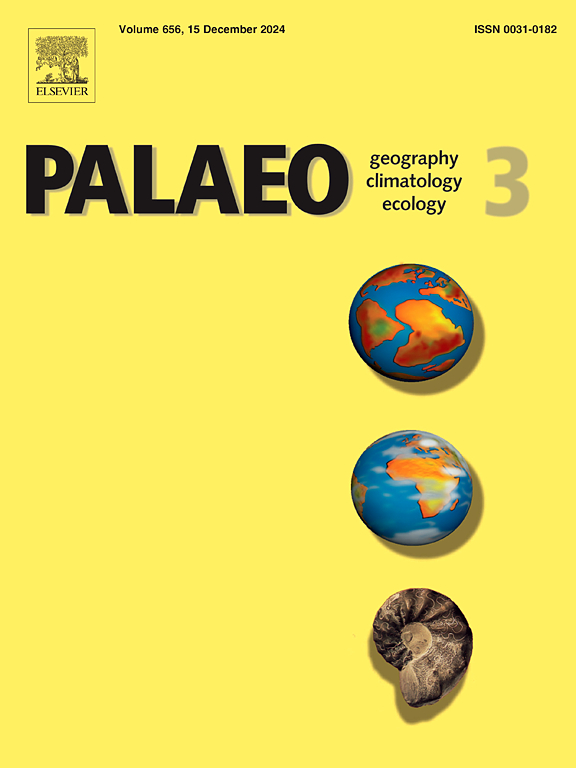在晚古生代化石记录中,气候,而不是来自“高地”或“盆地外低地”的运输,是耐旱陆地生物的原因
IF 2.6
2区 地球科学
Q2 GEOGRAPHY, PHYSICAL
Palaeogeography, Palaeoclimatology, Palaeoecology
Pub Date : 2025-07-22
DOI:10.1016/j.palaeo.2025.113160
引用次数: 0
摘要
长期以来,对宾夕法尼亚“煤时代”热带景观的解释沿着海拔梯度将其划分为:湿地、不耐旱的植物和动物占据低地和盆地,而越来越耐旱的植物和动物逐渐殖民到更偏远的地区,称为“盆地外低地”和“高地”。这个模型体现了一个不言自明的、长期存在的假设,即整个热带地区的气候广泛而均匀(温暖而潮湿)。景观环境梯度被设想为随着距离海岸线和海拔的距离而增加土壤排水的结果。因此,在盆地低地发现的耐旱生物,在很大程度上,被认为是从它们空间上遥远的栖息地迁移到那里的。在这里,我们回顾了一个最近的模型,该模型结合了地球历史上宾夕法尼亚亚期的冰川动力学。冰期-间冰期极地冰量的变化伴随着海平面、大气环流及其伴随气候和沉积动力学的同步变化。在热带盆地,这导致了高湿度和低季节性的时期,产生了广泛的不耐干旱生物(高保存潜力)的湿地,交替出现了高季节性和可变湿度的景观,由耐季节性干旱和干旱的生物(低保存潜力)居住。季节性干旱景观包括持续存在于湿润亚生境或局限于避难所的湿地形式。后一种气候模式包含了比单维高地模式更好的一整套生物、地质和建模结果,因此对化石记录具有更大的解释潜力。本文章由计算机程序翻译,如有差异,请以英文原文为准。
Climate, not transport from “uplands” or “extrabasinal lowlands,” is the cause of drought-tolerant terrestrial organisms in the late Paleozoic fossil record
A long-standing interpretation of the Pennsylvanian “Coal Age” tropical landscape partitions it along an elevational gradient, with wetland, drought-intolerant plants and animals occupying lowland, basinal settings, and increasingly drought-tolerant plants and animals colonizing progressively more remote areas, termed “extrabasinal lowlands” and “uplands”. This model embodies the unspoken, and long-held assumption of a broad, uniform climate across the tropics (warm and wet). The landscape environmental gradient is envisioned as the result of increasing soil drainage with distance from the shoreline and elevation. Consequently, drought-tolerant organisms found in basinal lowlands are, for the most part, assumed to have been transported there from their spatially remote habitats. Here we review a more recent model that incorporates the glacial dynamics of the Pennsylvanian Subperiod in Earth history. Changes in polar ice volume during glacial-interglacial cycles were accompanied by synchronous changes in sea level, atmospheric circulation and attendant climates, and sedimentary dynamics. In tropical basins this resulted in periods of high moisture and low seasonality, producing widespread wetlands with drought-intolerant organisms (high preservation potential), alternating with high-seasonality and variable moisture landscapes populated by organisms tolerant of seasonal dryness and drought (lower preservation potential). Seasonally dry landscapes included wetland forms persisting in wet sub-habitats, or confined to refugia. This latter Climate Model encompasses the full suite of biological, geological, and modeling results better than the unidimensional Upland Model and thus has far greater explanatory potential for the fossil record.
求助全文
通过发布文献求助,成功后即可免费获取论文全文。
去求助
来源期刊
CiteScore
5.90
自引率
10.00%
发文量
398
审稿时长
3.8 months
期刊介绍:
Palaeogeography, Palaeoclimatology, Palaeoecology is an international medium for the publication of high quality and multidisciplinary, original studies and comprehensive reviews in the field of palaeo-environmental geology. The journal aims at bringing together data with global implications from research in the many different disciplines involved in palaeo-environmental investigations.
By cutting across the boundaries of established sciences, it provides an interdisciplinary forum where issues of general interest can be discussed.

 求助内容:
求助内容: 应助结果提醒方式:
应助结果提醒方式:


